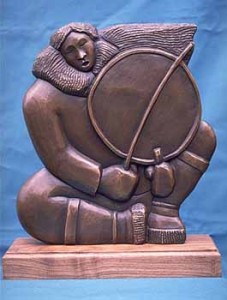Notes on Art and Cultural Survival
–Jaime Luria with Elizabeth Hutchinson
Columbia’s collection of drawings speaks to a long Inupiaq history of formal self-representation in both two and three-dimensional forms, a tradition that rests directly at a crossroads between the visual language of the West and a story of cultural continuity that permeates an enormous body of works by Inupiaq and other Native Alaskan artists. This history was in some ways enriched through intercultural contact, as it is in light of the changes incited by missionary work and other colonial endeavors that this material found a broader audience in museums and other public collections.
Rather than seeing the works in this exhibition as records of the destruction of Inupiaq life, it is more meaningful to consider this body a coherent statement of cultural continuity. Despite changes in media over time, Inupiaq artists have repeatedly returned to the same themes–the nuclear family, the home, hunting, and ceremony. In doing so, they have repeatedly reclaimed craftsmanship, attention to materials, and formal strategies such as the graphic representation of narrative and movement, as aspects of a transhistorical Inupiaq aesthetic. As contributions by other students on this website will demonstrate, the work of contemporary artists working in printmaking, film, and graphic design, engage similar aesthetic values as the drawings in this show and other early nineteenth century productions even as this work changed over time to reflect the evolving experience of being Inupiaq.
By stressing change as well as continuity, this exhibition resists the temptation to present arctic peoples as members of an unchanging, idyllic culture. From productions like Nanook of the North (1922) to Brother Bear (2003), the myth of the “happy Eskimo”, demonstrated by such examples of popular visual culture, is a powerful one. This story situates Native peoples somewhere in the past, somewhere exotic where humans and animals live harmoniously and unaffected by Euro-American influence.
In her treatment of Native arts and cultural expression in the context of colonial engagement, Ruth Phillips calls for an “holistic interpretive framework [that] applies not only to pre-modern objects, but also to traditional arts that have persisted into the present or that have been reintroduced through processes of revival and reinvention.” (Phillips 2004, 693) The historical and contemporary objects included on this website speak to a complex history of documenting and marking ceremonial and daily life from before the late nineteenth century to contemporary artistic representations of cultural identity and tribal history. It is through an interdisciplinary approach that I believe the relationships between visibility, agency, and expression present in these works is best explored.
Larry Ahvakana, Young Drummer in Relief, 1994 from www.ahvakana.com/Bronze/drmrrlfBRONZE.htm
Elsewhere in this website, Emilie Chedeville notes that Inupiat artist Larry Ahvakana undertakes the perpetuation of tribal aesthetic practices as a means of pointing to the past and maintaining an education in Inupiat cultural values in the present. Like Ahvakana, we might consider the artists whose work is on display here to be memory keepers making use of the materials presented them in their own time to speak to Inupiat communities of the past and those yet to come.
Source for this entry:
Ruth B. Phillips, “Making Sense Out/Of the Visual: Aboriginal Presentations and Representations in 19th Century Canada,” Art History Volume 27, Issue 4, September 2004, p. 693.


Leave a Reply
You must be logged in to post a comment.